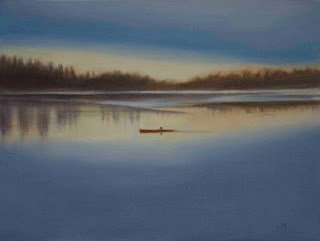Rublev Paints
 |
| Rublev Paints in their box |
 |
| Antica Green Earth and Nicosia Green thinned out |
A couple of weeks ago I was telling Deborah Paris of my difficulties with the wheat fields. She suggested I try several experiments (which I'm doing) and asked if I had Rublev's Yellow Ochre Light. (Why no I did not!) So the next day I had 6 tubes of Rublev paints headed my way.
They are lovely and more than that - seriously interesting for an oil painter/art history buff/married to a geologist. They are more fully called: Rublev Colours Artists' Oils, "Oil Paints from Natural Mineral, Organic and Historical Pigments for Fine Artists." These are single pigment, often granular because they are ground pigments, not synthetic and not ground to a consistent texture across their line of paints. They have a great range of transparent to opaque and clearly state what is what and where it's from. I like knowing that.
The top photo is of the pristine paints in the box. So clean, no drips or dried paint clogging the top. And the bottom photo are two transparent greens I wanted to tell you about. The top, blue green one is Nicosia Green Earth and I know this about it from the Rublev website:
"Rublev Colours Nicosia Green Earth is a transparent deep green with yellow undertones, medium grained and low tinting strength. Our Nicosia green earth is from glauconite deposits in Cyprus.
The color of glauconite, a mineral of hydrated iron potassium silicate, varies considerably from pale green to dark green and from bluish-green to olive-green, depending upon its constituent elements.
Natural green earths, such as Nicosia green, are transparent and are absolutely permanent in oil. Most oil colors labeled "green earth" from artists' paint manufacturers do not actually contain the natural mineral, but rather is a mixture of synthetic chromium oxide green and sometimes barium sulfate with either a natural yellow ochre or yellow iron oxide. Rublev Oil Colours Nicosia Green earth contains only the actual mineral and linseed oil.
Green earth was used in verdaccio--a style of underpainting that uses green-grey colors to establish values for later layers of paint. Verdaccio is renowned for being particularly effective when painting flesh tones. It was popular amongst Italian Renaissance artists, such as Leonardo da Vinci who used verdaccio underpainting in his masterpiece, the Mona Lisa.
The one on the bottom right is fantastic. It's Antica Green Earth from deposits in Prun, in the Verona region of Italy. It's an incredible transparent green with a nice earthy texture that brushes out transparent. Yesterday, as you can see from the palette, I was working with a mix of Antica Green Earth and the Nocosia green. To the right is a little yellow ochre mixed in. Yes, you should buy these. They are seriously great to work with.



Comments
Thanks John and Loriann! I was just in the studio again this morning with these ground minerals - I'm enjoying the effect.
Great to hear from you all the way from Scotland :). I think the paints make such a difference in glazing. You can email the company and ask about shipping - it's just a little ground up rock in vegetable oil after all!
I'm also a big fan of Rublev paints. I've had my eye on the Antica Green Earth and the Yellow Ocher Light for some time, and I will be trying them both out soon. They both look very useful. Of the tubes you showed, the Blue Ridge Yellow Ocher is simply one of the best paints I've ever used.
I also heartily recommend Rublev's lead paints - lead white, lead-tin yellow, lead-tin orange. Especially the lead white, it's best white I've ever used.
Cheers! - L.Lawrence